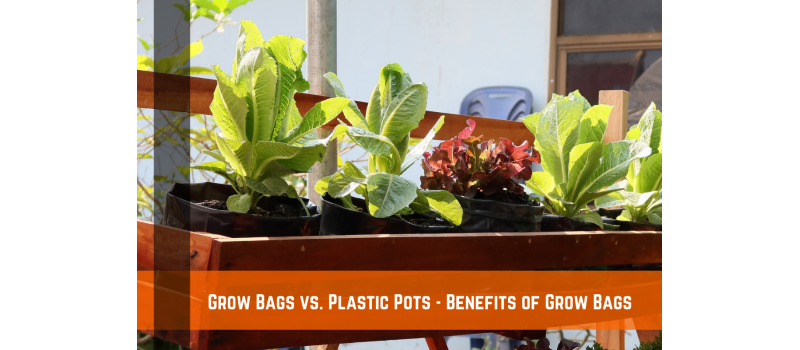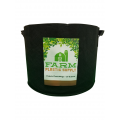When it comes to container gardening, choosing the right type of planter can make a big difference in your plants' health and overall yield. Grow bags and plastic pots are two popular options for home gardeners, but each has unique benefits and challenges. This guide will explore both to help you decide which is the best fit for your gardening needs.
What Are Grow Bags and Plastic Pots?
Grow Bags: Grow bags are breathable fabric containers used for growing a wide variety of plants. Made from materials such as non-woven polypropylene or felt, they allow for better airflow and drainage than solid containers. Grow bags are lightweight, collapsible, and available in various sizes.
Plastic Pots: Plastic pots are traditional planters made from durable plastic. They come in many shapes, colors, and sizes, making them versatile for different types of plants. Plastic pots are popular for their durability and affordability, especially in container gardening.
Drainage and Aeration: A Key Comparison
Grow Bags: One of the biggest advantages of grow bags is their excellent drainage. The porous fabric allows excess water to escape easily, preventing waterlogged roots. Additionally, the breathable material promotes better aeration, encouraging root pruning—where roots naturally stop growing once they reach the edge, creating a denser root system.
Plastic Pots: Plastic pots can retain water more effectively, which is beneficial for plants that thrive in consistently moist soil. However, this can also lead to overwatering, as plastic pots lack the natural breathability of grow bags. Unless there are enough drainage holes, water can accumulate at the bottom, causing root rot.
Mobility and Ease of Use
Grow Bags: Grow bags are lightweight and collapsible, making them easy to move around the garden or store when not in use. However, large grow bags filled with soil can be cumbersome to relocate, and they may lose their shape over time, making them harder to handle.
Plastic Pots: Plastic pots are durable and sturdy, offering better structure and stability for larger plants. They're easy to carry thanks to their rigid shape, and they often have rims or handles that make lifting easier. On the downside, they are less flexible and can crack under extreme weather conditions.
Temperature Control: Keeping Plants Comfortable
Grow Bags: Grow bags offer better temperature regulation since the fabric allows heat to escape more easily. This prevents roots from overheating, especially in hot climates or direct sunlight. However, in cooler weather, plants in grow bags may dry out faster due to the increased airflow.
Plastic Pots: Plastic pots retain more heat, which can be both a pro and a con. While the added warmth benefits plants in cooler environments, plastic pots can become too hot in direct sunlight, risking damage to the roots. Dark-colored pots, in particular, absorb more heat, which could harm heat-sensitive plants.
Longevity and Durability
Grow Bags: While grow bags are designed to be durable, they typically have a shorter lifespan than plastic pots. Continuous exposure to sun, water, and soil can degrade the material over time, especially after multiple growing seasons. However, proper care—such as storing them indoors during winter—can extend their life.
Plastic Pots: Plastic pots are more durable and can last for several years with minimal maintenance. They're resistant to water and pests, and some are even UV-treated to prevent sun damage. However, cheaper plastic pots may crack or fade over time, and broken plastic can be difficult to recycle.
Environmental Impact and Sustainability
Grow Bags: Many grow bags are made from recycled or biodegradable materials, making them an eco-friendlier option compared to plastic pots. Since they promote healthier root growth, grow bags can help plants thrive with less need for chemical fertilizers. At the end of their lifespan, some fabric grow bags can be composted, reducing waste.
Plastic Pots: Plastic pots contribute to the growing problem of plastic waste, especially if they're not recycled properly. While some pots are made from recycled plastic, many end up in landfills. That said, plastic pots are reusable, and high-quality ones can last for years, reducing the need for frequent replacements.
Which One Should You Choose?
The decision between grow bags and plastic pots depends on your specific gardening needs and preferences. Here’s a quick summary to help you decide:
Choose Grow Bags If:
You want better drainage and aeration.
You plan to grow heat-sensitive plants in a warm climate.
You prefer a more eco-friendly option.
You need lightweight containers that are easy to store when not in use.
Choose Plastic Pots If:
You need long-lasting, durable planters for multiple seasons.
You want more stability for large plants or trees.
You are gardening in cooler climates where heat retention is beneficial.
You prefer a wide variety of shapes, sizes, and colors.
Ultimately, many gardeners use a combination of both grow bags and plastic pots to take advantage of their unique benefits. For instance, grow bags can be ideal for vegetables, herbs, or flowers that need good aeration, while plastic pots are perfect for larger plants or perennials that require more stability.
Conclusion
Both grow bags and plastic pots have their strengths and challenges. By understanding the differences in drainage, temperature control, mobility, and environmental impact, you can make an informed decision based on what works best for your plants and gardening style. Whether you opt for the breathable convenience of grow bags or the durability of plastic pots, both options offer plenty of opportunities for a thriving garden.


